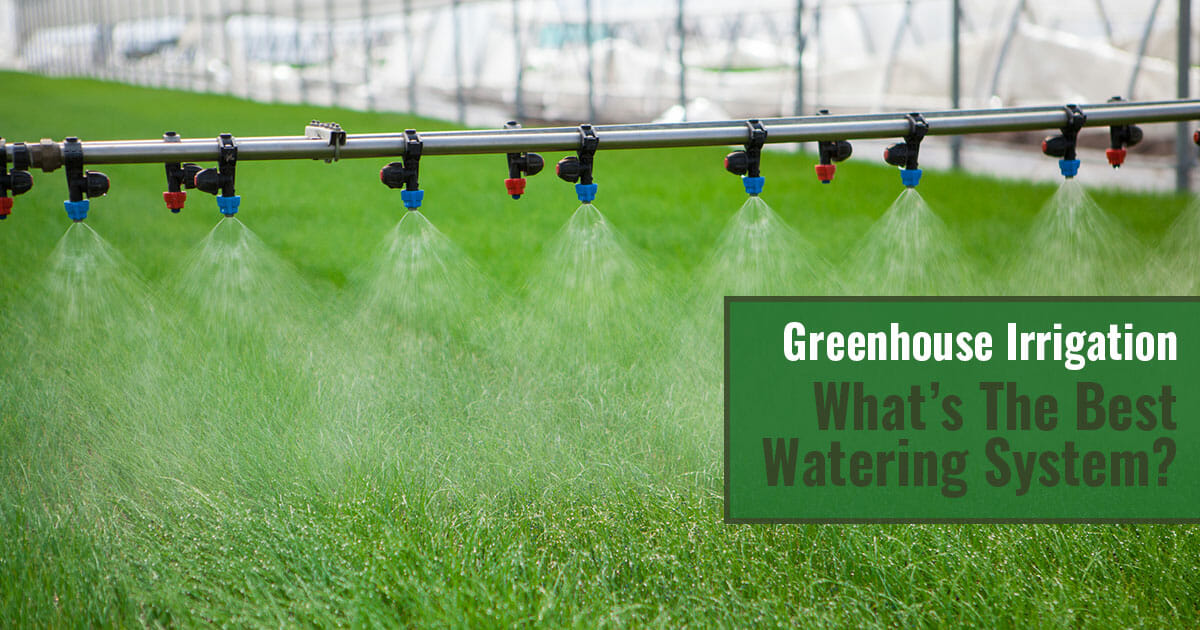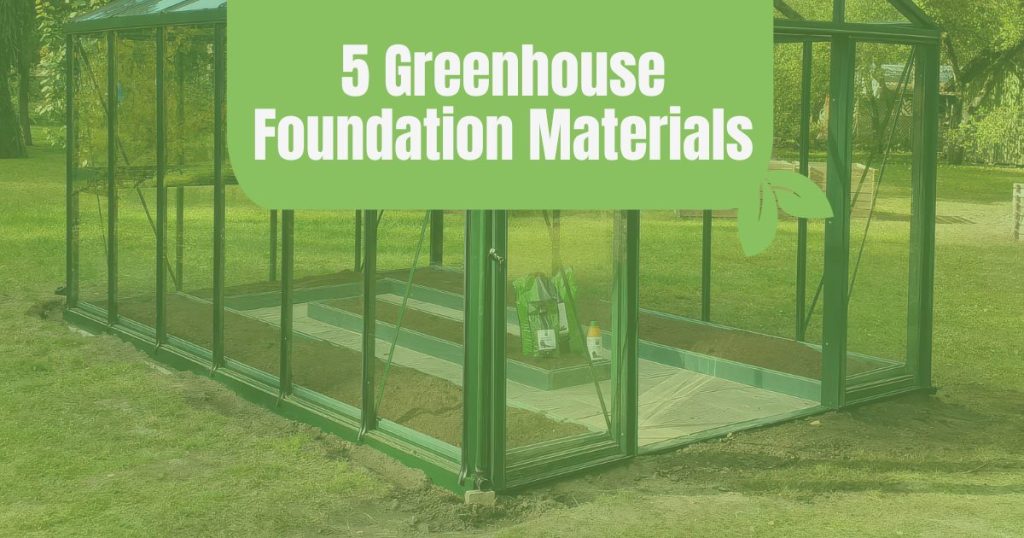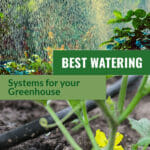
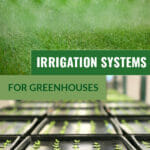
Selecting a proper irrigation system is vital to the growth of your plants. In a greenhouse, you can’t rely on the rain. So, you want to ensure that your plants get the perfect amount of water.
There are several irrigation systems to choose from which can be daunting. You need to select the type that suits your own needs the best. This includes the size of your greenhouse, the type of plants, and how much time you have to invest into gardening.
Let’s start from the very beginning. The best way of picking the right greenhouse irrigation system is to learn about every option you have. This way you can see which ones would (not) be suitable for your situation.
What type of irrigation systems are there?
When considering which watering method to adopt in your greenhouse, you should learn about the advantages and disadvantages of each of them. This way you can see which one would meet your and your plant’s watering needs.
Self-watering trays and capillary mats
This is probably the most uncomplicated watering method that still requires some manual work. They are a great choice for smaller greenhouses and novice growers. This may also be the perfect watering method for plants that don’t like water coming from above (e.g. orchids).
Self-watering trays give a constant water supply from below. They have a water compartment that releases moisture to the soil and planted plants above as long as there is water available. Some of them have a capillary mat that absorbs the water and releases it slowly. The potted plants can be placed on this wet mat and have access to water when they need it.
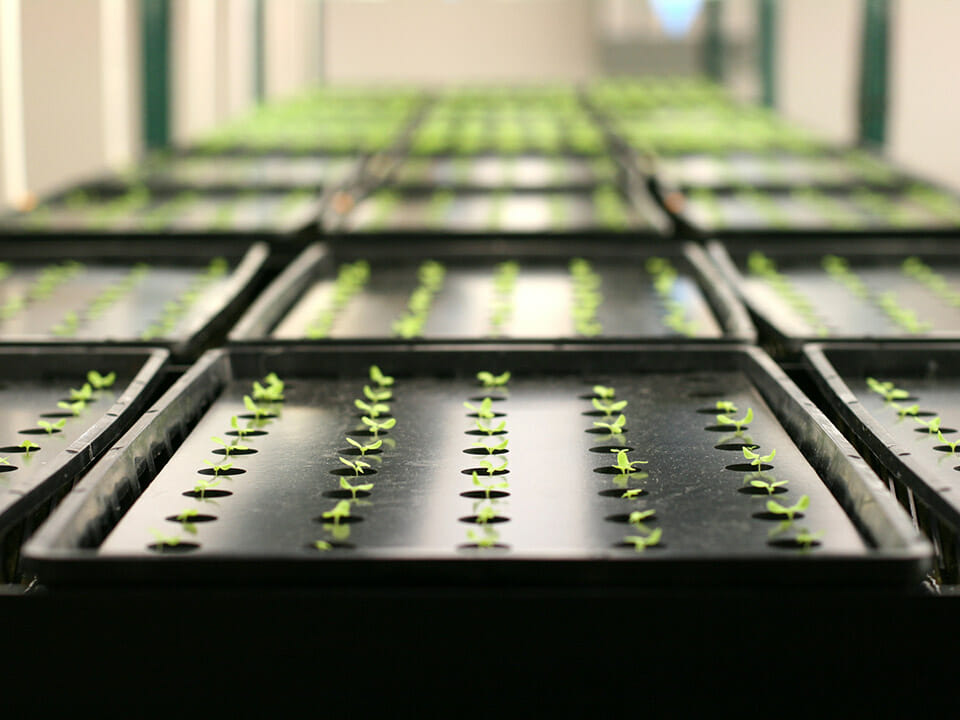
This watering system promotes deeper roots as their source of water is from below. Capillary matting and self-watering trays create a humid atmosphere that promotes plant growth and saves water.
As long as there is water in your reservoir, all of the plants will stay hydrated. Topping up reservoirs is done weekly. This makes it one of the lowest maintenance options available for amateur growers.
Pros
- Saves time & energy
- Affordable and labor-saving
- Easy to set up
- Delivers a consistent water supply
- Promotes better roots and plant growth
- Reduces risks of plant diseases caused by overhead or overwatering
Cons
- Not all growing mediums are good choices for this irrigation system
- The capillary mats can grow algae that may attract gnats
- Plants may still require top-side dosing of water to flush out fertilizers
- Not an automation that works on its own (still need to refill manually)
(Over-head) sprinklers
This irrigation system is usually used for crops that tolerate wet foliage. Overhead sprinklers utilize pipes placed above the plants and fitted with nozzles that can be adjusted to varying spray ranges. You can also install sprinklers in-ground (think lawn sprinklers) but in greenhouses it’s more common to mount them to the ceiling.
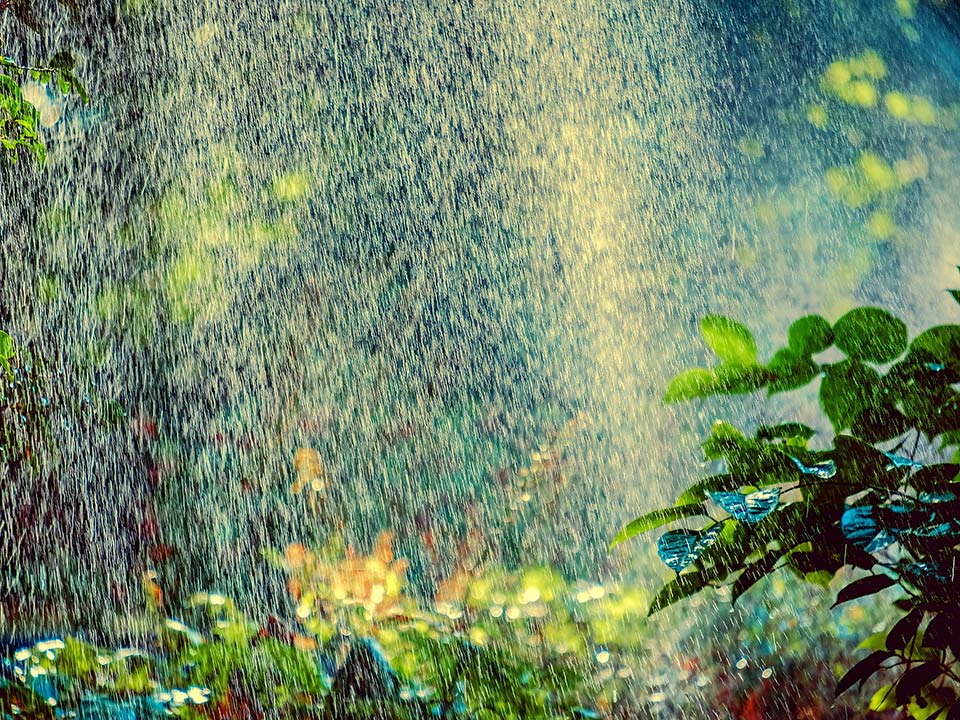
A sprinkler system saves time but it should be checked often to ensure it is working properly. Overhead sprinkler systems work best for watering small transplanted plants until they are ready to be placed in a garden or flower bed.
Pros
- Inexpensive and very easy to set up
- High and regular watering can be effectively achieved
- Easy to automate or to control manually
- Efficient on medium coarse-textured soils
Cons
- Creates an environment where plant diseases thrive due to leaf wetness and overhead watering
- Poor quality water can clog the sprinkler nozzles
- Operating cost may be high
- Frequent applications may be needed to recharge soil
- Uses more water: Water may evaporate because of heat or sunshine which increases water costs
- Water distribution (all is watered the same, no customization for specific greenhouse areas)
Misting (spray) system
This system is great for large greenhouses and propagating seedlings. It is the best option for a greenhouse with lots of seeds that need regular watering.
Misting systems only release small amounts of water droplets (mist). Sprinklers, on the other hand, use a lot more water when running and are only used for a short time. Misters can either run for longer or automatically spray every 15 or 30 min (depending on your needs).
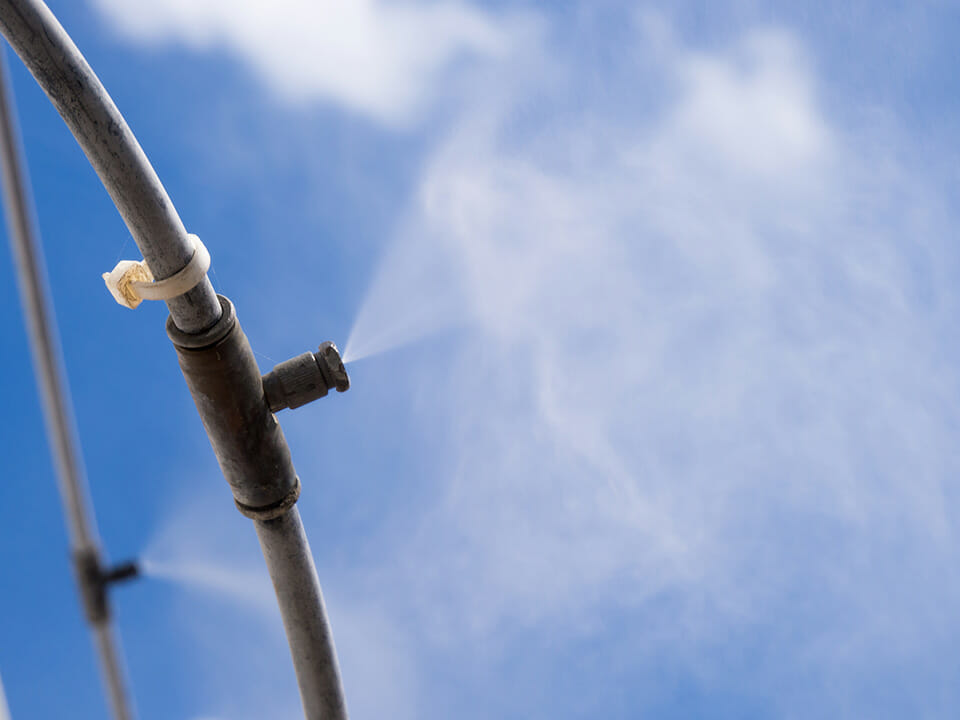
Having a misting system can decrease the temperature in the greenhouse which can be quite useful in summer or in warmer climates. Misters are also the perfect choice for tropical plants because it will increase the humidity.
Pros
- Can be timed and automated
- Helps with keeping the greenhouse cool
- Medium to low initial investment
- Perfect for greenhouses that need regular watering
- Perfect for tropical greenhouses
Cons
- Less efficient and wasteful if not managed properly
- Water distribution (all is watered the same, no customization for specific greenhouse areas)
- Some plants may not like the humidity that it creates
- Possible plant diseases caused by overhead watering and constant wet environment
Drip irrigation systems
The drip system is preferable because it is scalable to any size and good for all purposes. It is basically a hose with multiple heads (emitters) that release water at set intervals throughout the day.
A drip irrigation system can be set up on the surface or buried within the soil. The heads should be close to the plants for efficiency.
This system releases slow drips of water over time so plants do not dry out. This also minimizes water waste. It requires water pressure, so is often combined with a solar-powered pump from a water butt and can be completely automated.
The drip system is very useful for greenhouses of any size, as they can be scaled perfectly up or down.
Pros
- Can be automated and programmed based on many factors
- Reduces water usage (no evaporation, water on leaves)
- Better water distribution because you can adjust it precisely
- Emitters can be adjusted, closed, or opened
- Water can be collected, treated, and reused
Cons
- Requires electricity for pump
- Cleaning and maintaining the system can be challenging
- Further investments are required to collect, treat and reuse water
- May cost more to set up
- Clogging of nozzles could happen
Soaker hoses
This watering system is a little similar to drip irrigation. Soaker hoses also water the plants from below as they sit inside the soil.
These tubes don’t have emitters, though. The material is porous which means it constantly releases small amounts of water into the soil.
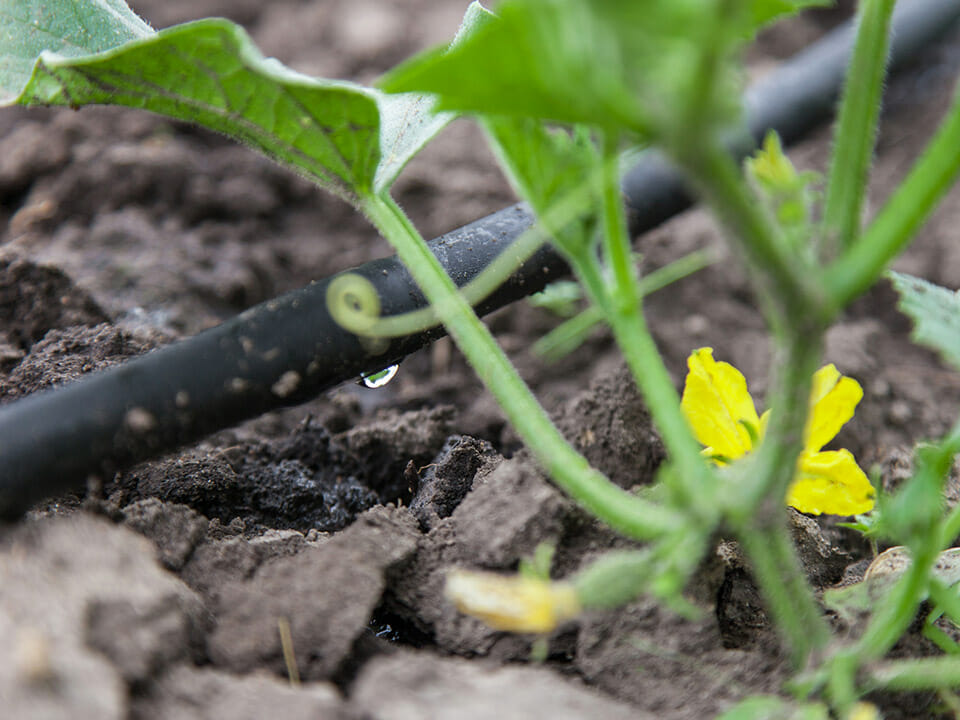
This is an effective way if you don’t want to plan the nozzles according to the distance of your plants. However, you cannot adjust the amount of water in specific areas. So, this watering system will work great for raised beds but not for individual pots.
Pros
- Easy installation
- Low maintenance
- Inexpensive
- No need for much planning
- Conservative with water as there won’t be any evaporation
- Can be automated with a tool at the faucet
- Clogging isn’t an issue
Cons
- No adjustments to water distribution
- Limited usability
- Must be installed relatively level
- Maintenance and repairs could be challenging
Off-grid solar-powered irrigation systems
Maybe you’re not a fan of running an irrigation system on power and that’s why you’ve been avoiding installing one. We totally understand!
Solar-powered irrigation systems require no water or electricity supply. This makes them completely self-sufficient and perfect for your smaller greenhouse. You could still attach it to a water hose in case you had a long drought.
Solar-powered irrigation systems come in the form of drip irrigation, connected to a rain barrel that utilizes the sun to pump water through the hose at regular intervals throughout the day.
Pros
- No fuel costs or electricity
- Environmentally friendly
- Less labor and maintenance
- pollution-free and causes no greenhouse gases to be emitted after installation
Cons
- Can’t pump water when it is dark
- High initial costs
- Requires lots of space as efficiency is not 100% yet
- Lower production in the winter months
Automated vs manual: 4 Reasons to switch to an automated irrigation system and 3 reasons NOT to choose automation
Many growers are searching for a stress-free watering system that’ll help them save time and resources. If this sounds like you, keep reading to find out more reasons to switch to an automated irrigation system.
Automated irrigation systems work on a timer and provide your plants with the same amount of water each time. This is very helpful for large projects where manual watering may be too time-consuming. People who are busy during the week also benefit from an automated system.
Pros of automated irrigation systems
1. Saves time
This is the reason why people pick automated irrigation. Once set up properly, it’ll do its job and you can take care of other things with your newly won time.
No more manual watering and you don’t even have to be present when your plants are getting watered.
2. Focus on caring for plants and harvesting
Sure, watering is part of taking care of plants but you could use that time to check on your plants, weeding, feeding, trimming, pollinating, or harvesting. There are still a lot of other tasks when it comes to greenhouse gardening. So, freeing up some of your time by automating the irrigation task will be a great idea!
3. Improves efficiency
Automatic systems provide precise coverage, eliminating concerns of over or underwatering your plants. Timers can be set for daily or weekly watering and at times of low evaporation.
Additionally, smart moisture sensors can be installed for many systems. These measure precipitation rates in real-time, and activate only when your soil is dry.
4. Cost-effective
An automated system ensures that water is allocated effectively so your plants get watered at the ideal time and with the ideal amount. This helps to prevent wastage and also cuts down the water bill. However, keep in mind this highly depends on the irrigation system you choose as described above.
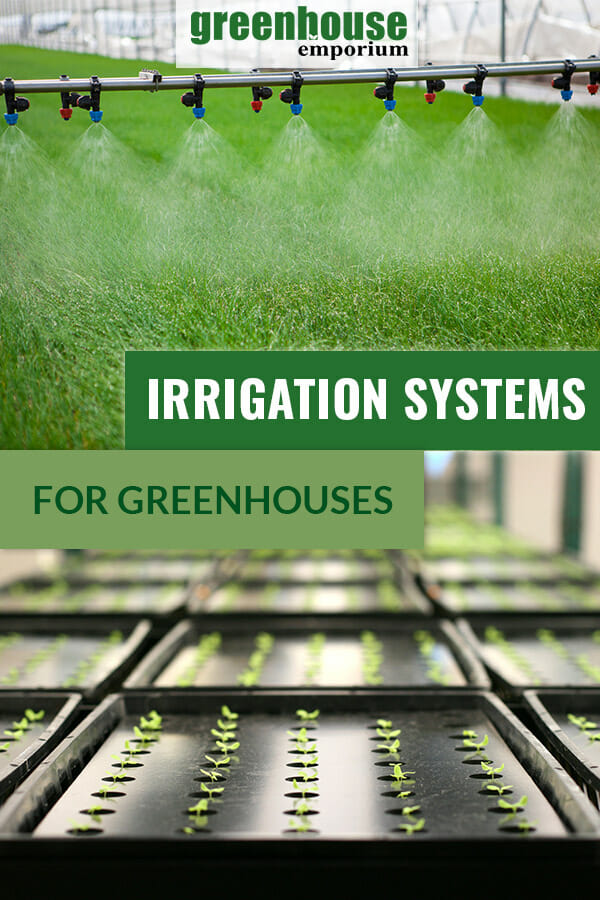
Cons of automated irrigation systems
1. Relatively expensive
The main disadvantage associated with an automated system is the expense. These systems can be quite costly depending on the size of your greenhouse and what features you want. While some simple timers only cost $25, there are always better and more expensive options with more features (phone operated, soil analyzer, etc).
2. Rigorous and time-consuming installation process
The installation process of an automated irrigation system can take some time (depending on the system). Some are very simple (installed on the hose), while others require professionals to dig up the area to install the pipework and attach it to the plumbing system of your greenhouse.
This procedure can take up days or weeks. Afterward, the landscape will have to be repaired. But once the system is set up, you will continue to enjoy and appreciate the value of an automated irrigation system
3. Faults may cause water wastage and pests to thrive
If you don’t set it up properly, you will waste a lot of water. Overwatering can also give a good ground for diseases and pests to thrive. Of course, this can be avoided by setting it up correctly and by checking your greenhouse after each scheduled watering for the first couple weeks.
So, which greenhouse irrigation system is the best?
Now, we hope that you’ll be able to answer this yourself. If not, let’s go through the main facts real briefly. Generally, drip irrigation and soaker hoses are preferred because they serve the water from below. They are superior for water management and precise watering. The drip system is a multi-purpose system. So if you are looking out for an option that you can scale to any size, consider the drip system.
Overhead watering will use more water and it can (but doesn’t have to) cause plant diseases or pests.
If you have tropical plants that love a wet climate or if you need to cool your greenhouse (think Southern states), you may go with the misting system as it will be more suitable for your needs.
Overall, all watering systems can be irrigated automatically (powered or off-grid) so you can water crops with minimal stress.
Picking the right irrigation system for your greenhouse is the key and there is always a system out there that will suit your needs. You must be realistic about the size of your greenhouse, the plants you can grow, and how much you can afford to invest in an irrigation system.

